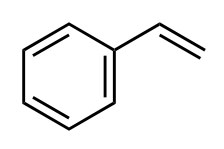 What is Styrene?
What is Styrene?
Styrene is primarily a synthetic chemical. It is also known as vinylbenzene, ethenylbenzene, cinnamene, or phenylethylene. It’s a colorless liquid that evaporates easily and has a sweet smell. It often contains other chemicals that give it a sharp, unpleasant smell. It dissolves in some liquids but doesn’t dissolve easily in water.
Uses
Styrene is used predominately in the production of polystyrene plastics and resins. Styrene is also used as an intermediate in the synthesis of materials used for ion exchange resins and to produce copolymers.
Sources & Potential Exposure
Low levels of styrene also occur naturally in a variety of foods such as fruits, vegetables, nuts, beverages, and meats.Acute (short-term) exposure to styrene in humans results in mucous membrane and eye irritation, and gastrointestinal effects. Chronic (long-term) exposure to styrene in humans results in effects on the central nervous system (CNS), such as headache, fatigue, weakness, and depression, CSN dysfunction, hearing loss, and peripheral neuropathy.
Human studies are inconclusive on the reproductive and developmental effects of styrene; several studies did not report an increase in developmental effects in women who worked in the plastics industry, while an increased frequency of spontaneous abortions and decreased frequency of births were reported in another study. Several epidemiologic studies suggest there may be an association between styrene exposure and an increased risk of leukemia and lymphoma. However, the evidence is inconclusive due to confounding factors.
Federal Regulations
EPA has not given a formal carcinogen classification to styrene.

 Americas
Americas Europe
Europe Français
Français Deutsch
Deutsch Italiano
Italiano Español
Español



